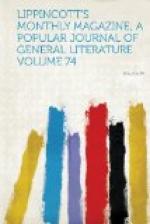Your love and pity doth the
impression fill
Which vulgar scandal stamped
upon my brow,
and triumphantly asks, “If that doesn’t refer to the scar, what does it refer to?”
The Sonnets of Shakespeare have been quite too much neglected by the lovers of his plays, and Stevens said that the strongest act of Parliament that could be framed would fail to compel readers into their service. Two classes of minds, however, have always pondered over them—the poets, who could not fail to appreciate their wonderful power and beauty, and the psychologists, who have found in them an ample field for speculation. The variety and extent of the theories of these latter gentlemen can only be rivaled by the feat of the camel-evolving German. Indeed, it is the true German school of thought to which these speculations belong, and it is but just that to a genuine Teuton belongs the honor of the most extraordinary solution of the mystery yet given. It would take too long to sum up all the theories that have been broached upon the subject, but two or three will do as an example. Without stopping to dwell upon the ideas of M. Philarete Chasles, or of Gen. Hitchcock, who believes the Sonnets to be addressed to the Ideal Beauty, we will pass on to the book of Mr. Henry Browne, published in London in 1870. His idea is that the Sonnets are dedicated to William Herbert, afterward earl of Pembroke, and are intended chiefly as a parody upon the reigning fashion of mistress-sonneting and upon the sonneteers of the day, especially Davies and Drayton; that they also contain much which is valuable in the way of autobiography, and that “the key to the whole mystery lies in Shakespeare’s conceit (i. e., Mr. Browne’s conceit) of the union of his friend and his Muse by marriage of verse and mind; by which means, and for which favor, his youth and beauty are immortalized, but which theme does not fully commence till the friend had declined the invitation to marriage, which refusal begets the mystic melody.” Mr. Browne graciously accepts the Sonnets in their order, and professes to be unable to name the real mistress of Herbert, though he considers Lady Penelope Rich to be the object of their allegorical satire.




